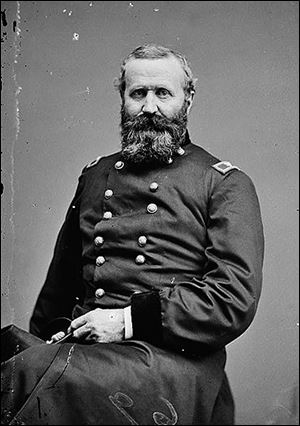
WHEN PITTSBURGH STOOD STILL
150 years ago, a Civil War stalwart fell
Gen. Hays eulogized for making cowards brave
5/5/2014
Gen. Alexander Hays of the Union Army was killed 150 years ago today in the Battle of the Wilderness during the Civil War. Pittsburgh businesses closed so residents could attend his funeral on May 14.
PITTSBURGH — After 32 battles, Union Gen. Alexander Hays’ luck ran out in rural Virginia 150 years ago today.
He was shot in the head and died a few hours later.
His death on May 5, 1864, made him one of the early casualties among the 29,000 Union and Confederate soldiers killed, wounded, or missing during what became known as the Battle of the Wilderness.
A native of Franklin, Venango County, and a graduate of West Point, General Hays had served bravely during the Mexican War.
Resigning his commission, he worked as a railroad construction engineer, iron master, and miner in the California gold fields. After returning to Pennsylvania, he worked as a civil engineer.
As soon as the Civil War began, he rejoined the U.S. Army.
Serving as colonel of the 63rd Pennsylvania Infantry, he took part in much of the early fighting. Leading from the front, he had multiple horses shot out from under him and was wounded twice.
His leg was shattered during the Second Battle of Bull Run in August, 1862.
While “still hobbling on a crutch,” he sought to return to service, turning up in Washington. “His physicians, having examined his wound, declared him totally unfit for duty in the field,” according to the Nov. 26, 1862, edition of The Daily Pittsburgh Gazette.
The Gazette’s reporter said there was talk in Washington that General Hays might be appointed military governor of the capital, replacing Gen. James S. Wadsworth. That appointment never came through.
General Hays eventually got another field command. He led troops at Gettysburg in July, 1863, and went south as a brigade commander with Gen. Ulysses S. Grant in the spring of 1864.
General Grant’s Overland Campaign was another effort to destroy Robert E. Lee’s Army of Northern Virginia.
General Hays’ death on May 5 and funeral on May 14 in Pittsburgh were the subjects of multiple news stories.
During General Grant’s advance through Virginia, General Hays’ troops had been hammered by a Confederate counterattack led by Gen. James Longstreet.
“Gen. Hays with his brigade occupied a front position in the thickest of the fight,” the Gazette reported on May 16. Riding across his line, he “halted at the head of his old regiment (the 63d),” the story said. “He had scarce paused when a rifle ball struck him just above the cord of his hat, and … he fell insensible to the ground.
“Thus fell the hero of thirty-two battle fields,” the Gazette said. “He fell just where he should have wished to have fallen — at the head of his old regiment — the 63d Pennsylvania.”
The newspaper story said that General Hays was not only valiant himself, but also had the power to make others courageous.
“His best eulogium is contained in the words of one of his own comrades in arms who said that his simple presence would make a regiment of cowards brave.”
On May 14, the day of General Hays’ funeral, Pittsburgh Mayor James Lowry, Jr., asked “all manufacturers, shopkeepers, and others to close their places of business between the hours of one and five o’clock, that the public may generally have an opportunity to attend the funeral and pay a last tribute to the memory of the illustrious deceased.”
General Hays’ body was moved from the home of his father-in-law, John B. McFaddon, and into First Presbyterian Church in downtown Pittsburgh.
“Thousands of citizens, of both sexes and of every condition in life, visited the church to look for the last time upon the face of the illustrious patriot,” the newspaper said. “Among those who came to gaze on the features of the dead were some who had known him as a soldier and fought under his command.”
The Rev. William M. Paxton, who gave the eulogy, quoted from a letter General Hays had written just before the start of Grant’s Overland Campaign.
The morning had been beautiful as the troops began their march, General Hays wrote, “but it only brought to remembrance, through the throats of many bugles, that duty enjoined upon each one, perhaps before the setting sun, to lay down a life for his country.”
Five swords were placed on the general’s coffin.
“One — the gift of his early friends and companions in his native town (Franklin), as the reward for his gallantry in the battles of Palo Alto and Resaca de la Palma. Another — a token of affection and admiration from the Texas Rangers. A third — presented to him by his own company (the City Guards) … The fourth — an elegant and expensive sword recently presented to him as a testimony of the confidence and regard of the citizens of Pittsburgh. The fifth — his battle sword, which he carried when he fell on the field of carnage.”
Following the service, his funeral cortege moved along Wood Street to Liberty, up Hand Street (now Ninth Street) to what is now Penn Avenue, and then out to Allegheny Cemetery in Lawrenceville.
General Hays’ body lies under a granite memorial topped by an eagle and listing the Civil War battles in which he fought.
The Block News Alliance consists of The Blade and the Pittsburgh Post-Gazette. Len Barcousky is a reporter for the Post-Gazette.
Contact Len Barcousky at: lbarcousky@post-gazette.com or 724-772-0184.